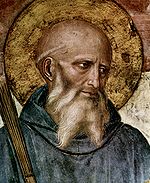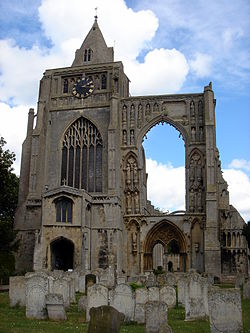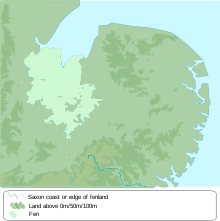- Crowland Abbey
-
Croyland Abbey
Croyland AbbeyDenomination Church of England Churchmanship Broad Church Website crowlandabbey.org.uk History Dedication Blessed Virgin Mary, Saint Bartholomew and Saint Guthlac, Administration Parish Crowland Deanery Elloe West Diocese Lincoln Province Canterbury Clergy Vicar(s) Revd Charles Brown Crowland Abbey (also spelled Croyland Abbey) is a Church of England parish church, formerly part of a Benedictine abbey church, in Crowland in the English county of Lincolnshire.[1]
Contents
History
A monk named Guthlac came to what was then an island in the Fens to live the life of a hermit and he dwelt at Croyland between 699 and 714. Following in Guthlac’s footsteps, a monastic community came into being here in the 8th century. Croyland Abbey was dedicated to Saint Mary the Virgin, Saint Bartholomew and Saint Guthlac. During the third quarter of the 10th century, Crowland came into the possession of the nobleman Turketul, a relative of Osketel, Archbishop of York. Turketul, a cleric, became abbot there and endowed the abbey with many estates. It is thought that, about this time, Crowland adopted the Benedictine rule.
In 1537, the abbot of Croyland wrote to Thomas Cromwell, sending him a gift of fish: "ryght mekely besechyng yow lordship favorablye to accepte the same fyshe, and to be gud and favorable lorde unto me and my pore house". Despite these representations, the abbey was dissolved in 1539. The monastic buildings, including the chancel, transepts and crossing of the church appear to have been demolished fairly promptly but the nave and aisles had been used as the parish church and continued in that role.
The town was captured after a short siege by Parliamentarian forces in 1643[2] and this appears to have been when very serious damage was done to the structure. The nave roof fell in 1720, the main south wall was taken down in 1744. The north aisle of the nave was refurbished and remains in use as the parish church.
Crowland is well known to historians as the probable home of the Croyland Chronicle of Pseudo-Ingulf, begun by one of its monks and continued by several other hands.
The church contains a skull which is identified as the skull of the 9th century Abbot Theodore who was killed at the altar by Vikings. The relic used to be on public view until it was stolen from its display case in 1982. The skull was returned anonymously in 1999.
John Clare wrote a sonnet entitled 'Crowland Abbey' which was first published in The Literary Souvenir for 1828 and reprinted in his last book, The Rural Muse in 1835.[3]
List of abbots of Crowland
Main article: Abbot of CrowlandOrgan
The abbey has a small two manual pipe organ. A specification of the organ can be found on the National Pipe Organ Register.[4]
Burials
References
- ^ "National Monument Record for Crowland Abbey". http://www.pastscape.org.uk/hob.aspx?hob_id=352270.
- ^ "a Fenland Notes and Queries; April 1899, article on a piece of Parliamentarian propaganda.". http://boar.org.uk/ariwxo3FNQ761.htm.
- ^ ['Triumphs of Time': John Clare and the Uses of Antiquity, by Bob Heyes from the John Clare Society Journal, no. 16 (July 1997) http://www.johnclare.info/main/heyes.html]
- ^ "National Pipe Organ Register entry for Crowland". http://www.npor.org.uk/cgi-bin/Rsearch.cgi?Fn=Rsearch&rec_index=N14443.
External links
- Crowland (Croyland) Abbey video retrieved 18 Dec 2010
- Croyland Abbey Official Website
- "Abbey of Croyland". Catholic Encyclopedia. New York: Robert Appleton Company. 1913. http://www.newadvent.org/cathen/04541a.htm.
Coordinates: 52°40′35″N 0°09′55″W / 52.67638°N 0.16521°W
Benedictine abbeys and priories in medieval England and Wales Independent houses Abergavenny · Abbotsbury · Abingdon · Alcester · Athelney · Bardney · Bath · Battle · Bedford · Birkenhead · Bradwell · Buckfast · Burton · Bury St Edmunds · Canterbury (Christ Church) · Canterbury (St Augustine's) · Canwell · Cerne · Chertsey · Chester · Cholsey · Colchester · Coventry · Crowland · Durham · Ely · Evesham · Eynsham · Faversham · Glastonbury · Gloucester · Humberston · Luffield · Malmesbury · Milton · Monk Bretton · Muchelney · Mullicourt · Norwich (Holy Trinity) · Pershore · Peterborough · Ramsey · Reading · Rochester · St Albans · St Benet of Hulme · Sandwell · Selby · Sherborne · Shrewsbury · Snelshall · Tavistock · Tewkesbury · Thorney · Upholland · Walden · Westminster · Whitby · Winchcombe · Winchester (New Minister) · Winchester (St Swithun) · Worcester · York (St Mary's)

Dependent houses Aldeby · Alkborough · Alcester · Alvecote · Beadlow · Bedemans Berg · Belvoir · Binham · Brecon · Bristol · Bromfield · Cardiff · Cardigan · Cranborne · Darenth · Deeping · Dover · Dunster · Earls Colne · Ewenny · Ewyas Harold · Exeter · Farne · Felixstowe · Finchale · Freiston · Great Malvern · Hatfield Peverel · Henes (Sandtoft) · Hereford · Hertford · Holy Island · Horton · Hoxne · Hurley · Jarrow · Kidwelly · Kilpeck · Kings Lynn · Lamanna · Leominster · Leonard Stanley · Lincoln · Little Malvern · Littlemore · Lytham · Middlesbrough · Monkwearmouth · Morville · Norwich (St Leonard) · Oxford (of Canterbury) · Oxford (of Durham) · Oxford (of Gloucester) · Penwortham · Pilton · Redbourn · Richmond · Rumsburgh · St Bees · St Ives · Scilly · Snaith · Snape · Stamford · Studley · Sudbury · Tickhill · Tynemouth · Wallingford · Westbury-on-Trym · Wetheral · Wymondham · Yarmouth
Alien priories Allerton Mauleverer · Andover · Andwell · Appuldurcombe · Arundel · Astley · Aston Priors · Atherington · Avebury · Axmouth · Blyth · Boxgrove · Brimpsfield · Burstall · Burwell · Caldy · Carisbrooke · Chepstow · Clatford · Cogges · Corsham · Covenham · Cowick · Creeting · Debden · Deerhurst · Dunwich · Ecclesfield · Edith Weston · Ellingham · Everdon · Eye · Folkestone · Frampton · Goldcliff · Grovebury · Hamble · Harmondsworth · Hatfield Regis · Haugham · Hayling · Headley · Hinckley · Holbeck · Horsham St Faith · Horsley · Lancaster · Lapley · Lewisham · Linton (or Isleham) · Livers Ocle · Llangennith · Llangua · Loders · Minster · Minster Lovell · Minting · Modbury · Monks Kirkby · Monk Sherbourne · Monmouth · Newent · Ogbourne St George · Otterton · Panfield · Pembroke · Pill · Ruislip · Runcton · St Cross · St Dogmells · St Michael's Mount · St Neots · Sele · Spalding · Sporle · Standon · Steventon · Stogursey · Stoke-by-Clare · Stratfied Saye · Swavesey · Takeley · Throwley · Tickford · Titley · Toft Monks · Totnes · Tutbury · Tywardreath · Upavon · Ware · Wareham · Warminghurst · Warmington · Wath · Weedon Beck · Weedon Lois · West Mersea · Wilsford · Wing · Winghale · Wolston · Wootton Wawen · York (Holy Trinity)
Categories:- Christian monasteries established in the 8th century
- 1539 disestablishments
- Monasteries in Lincolnshire
- Visitor attractions in Lincolnshire
- Benedictine monasteries in England
- Church of England churches in Lincolnshire
- Ruins in Lincolnshire
Wikimedia Foundation. 2010.


